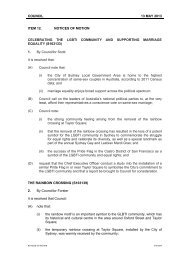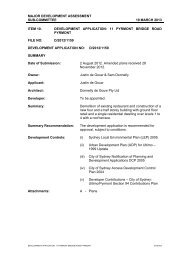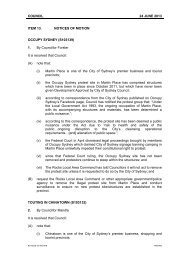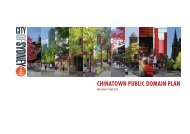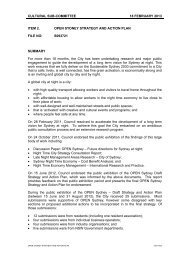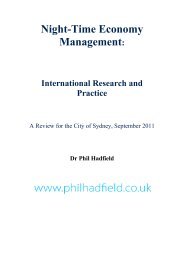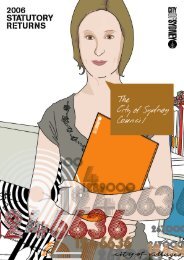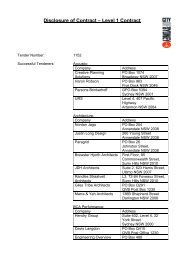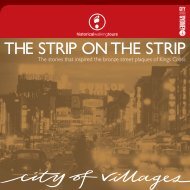Histories of Green Square - City of Sydney
Histories of Green Square - City of Sydney
Histories of Green Square - City of Sydney
You also want an ePaper? Increase the reach of your titles
YUMPU automatically turns print PDFs into web optimized ePapers that Google loves.
<strong>Histories</strong> <strong>of</strong> <strong>Green</strong> <strong>Square</strong><br />
Fig. 6.1 Photographer Sam Hood captured this portrait <strong>of</strong> local Alexandria people who had gathered to watch a fire <strong>of</strong> the<br />
Metters factory in 1934. (Source: Sam Hood, ‘Crowds watch over the back fence’, Hood Collection, courtesy <strong>of</strong> the<br />
Mitchell Library, State Library <strong>of</strong> NSW.)<br />
The earlier industries were rural-based and demonstrate the<br />
relationship between the growing town and its rural hinterland.<br />
The Lachlan and Waterloo Mills represent some <strong>of</strong><br />
Australia’s first industries. 5 They were originally built for<br />
grinding wheat but in 1827 they were converted into woollen<br />
mills. Wool was a continually expanding industry at this time,<br />
strongly supported by Commissioner Bigge who had been<br />
sent from Britain to inspect the colony in 1819. 6 As historian<br />
Lucy Turnbull observes ‘The wool industry was the fuel that<br />
ignited the economic boom <strong>of</strong> the 1830s’. Wool led pastoralists<br />
to rapidly invade Aboriginal lands in the interior. But<br />
transporting, processing, storing and exporting wool ironically<br />
also fostered <strong>Sydney</strong>’s development. 7 Wool shaped the<br />
fortunes <strong>of</strong> the city: when the first economic bust occurred in<br />
the 1840s the collapse <strong>of</strong> the wool industry played a major part<br />
in the financial crash. When drought hit wool prices, <strong>Sydney</strong>’s<br />
industries took it hard. Many new companies, which had been<br />
established in the previous decade, fell apart. The new mills at<br />
Waterloo were lucky to survive.<br />
Another industry established before 1850 was Hinchcliff’s<br />
Waterloo Mills wool washing establishment set up in 1848<br />
on the Waterloo Dam, which had originally been constructed<br />
by Simeon Lord for his mill (see also Chapter 4). The Hinchcliff<br />
mill was located at what is today the corner <strong>of</strong> Allen and<br />
George streets in Waterloo. 8 Woolwashing was important<br />
for the industry because the wool had to be cleaned <strong>of</strong> the<br />
oily lanolin and dirt before it was exported to Britain or sold<br />
locally. 9 The area continued to be an important centre for<br />
the wool industry into the second half <strong>of</strong> the century, with<br />
continual developments <strong>of</strong> new technologies. One establishment,<br />
Ebsworth’s woolscouring works, was well known for its<br />
technique <strong>of</strong> drying the wool with hot air. 10<br />
50<br />
6.2.2. Phase 2: 1850–1900<br />
The area around Redfern was developed as a working class<br />
residential area in the 1860s, and Alexandria and Waterloo’s<br />
suburbs grew in the latter part <strong>of</strong> the nineteenth century. 11 But<br />
the area was not a completely ‘industrial landscape’ early in<br />
this phase. Factories were sparsely spread out around the area.<br />
By 1871 the Hinchliff works were still surrounded by open<br />
ground, and the prime industries at this time were still rurally<br />
based trades. A Health Board Inspector’s 1876 report gave ‘the<br />
impression <strong>of</strong> large parts <strong>of</strong> the area as “semi-rural”, that is,<br />
without large accumulations <strong>of</strong> population and with much<br />
market gardening’. 12<br />
More industries were established in the area in the 1880s.<br />
They were attracted to Alexandria and Waterloo by the flat<br />
landscape, the availability <strong>of</strong> water, the close proximity to the<br />
city and Port Jackson and the railway at Eveleigh. 13 They were<br />
also mainly noxious trades which had either been banned<br />
from the city or were increasingly unacceptable as <strong>Sydney</strong> was<br />
transforming into a business district rather than an industrial<br />
centre.<br />
The South <strong>Sydney</strong> Heritage Study provides a list <strong>of</strong> industries in<br />
the wider South <strong>Sydney</strong> area (Alexandria, Waterloo, Redfern)<br />
in the nineteenth century. It lists forty-three types <strong>of</strong> industry,<br />
including breweries, wool washing, soap works, brickworks,<br />
dairy, market gardens, tanneries, boiling down works, glass<br />
works and the <strong>Sydney</strong> Jam Factory (later known to workers as<br />
‘The Jammy’). 14 At Hinchcliff’s wool washing establishment,<br />
there were approximately one-hundred hands employed,<br />
most <strong>of</strong> whom lived on the estate, and ‘wool was conveyed<br />
to <strong>Sydney</strong> three times a day. 15 The Goodlet and Smith Brickwork’s<br />
on Botany Road, Waterloo was established in 1855 and<br />
covered four to five acres <strong>of</strong> land (now the block between<br />
Epsom and Cressy Streets), producing bricks for <strong>Sydney</strong>’s<br />
rapid expansion. 16 Overall, though, many <strong>of</strong> these industries<br />
© Susannah Frith<br />
were small-scale companies, employing between ten and fifty<br />
men, boys and girls.<br />
The Royal Commission <strong>of</strong> Inquiry into Noxious Trades outlined<br />
the type, condition and practices <strong>of</strong> industries that existed in<br />
1883. Mr James Johnson’s Wool-washing and Fellmongering<br />
in Waterloo carried out ‘the businesses <strong>of</strong> wool-washing,<br />
sorting, pressing, and fellmongering’ in buildings <strong>of</strong> iron and<br />
wood ‘in fair repair’. The place boasted a steam engine with<br />
two boilers, sweating-room and soak-pit, and ‘all other requisites<br />
for a large business’. It employed on average ‘forty men<br />
and six boys’. Two dams supplied water, while the excess water<br />
drained from the surface into a creek and thence into Shea’s<br />
Creek, along with all the ‘refuse’. The works processed 5,000<br />
bales a year, including the wool taken from skins. 17 The Commissioners<br />
were refused entry into the Alderson Tannery so<br />
they were unable to inspect it. A map <strong>of</strong> Waterloo dating from<br />
around 1885 showed approximately fourteen identifiable<br />
industrial sites, including two breweries, three soap works, a<br />
rope works, three wool washes, a dairy, a brickworks, a pottery,<br />
a tallow works and a flour mill on the corner <strong>of</strong> Pitt and Wellington<br />
streets.<br />
The Royal Commission into Noxious Trades also gave some<br />
insight into what it would have been like to live close to such<br />
industries. Witnesses complained <strong>of</strong> the smells from the dyes<br />
in the tanning and leather industries and meat in the slaughterhouses<br />
prominent in the area. Together with smoke from<br />
the chimneys, these stinks created an atmosphere rather<br />
different to the Waterloo we know today. 18 As Scott Cumming<br />
discusses in Chapter 4, many <strong>of</strong> these noxious industries were<br />
based around the Alexandria Canal and washed their waste<br />
straight into it, so the quality <strong>of</strong> the water would have been<br />
appalling.<br />
But these industries also provided much needed employment<br />
in <strong>Sydney</strong>, especially during the hard years <strong>of</strong> the depression<br />
<strong>of</strong> the 1890s, and again in the 1920s. Fitzgerald observes that,<br />
already in the 1860s, 74 per cent <strong>of</strong> Alexandria’s population<br />
were blue collar workers—‘far exceeding the metropolitan<br />
average’, with ‘not a single doctor, clergyman or lawyer’. 19 Cable<br />
and Annable trace the location <strong>of</strong> working class residents in<br />
the areas <strong>of</strong> Alexandria and Waterloo:<br />
In Alexandria in the 1870s those occupants who are<br />
identified as ‘gardeners’ appear to be resident in the<br />
areas <strong>of</strong> Wyndham Road, Buckland Street, Ricketty<br />
Road, Mitchell Road and Garden Street, with dairymen<br />
on Mitchell Road, Wyndham Street and Botany Road.<br />
In the late 1880s…by contrast the area along Barwon<br />
Park Road was devoted to brickworks. 20<br />
According to some, the living conditions for workers were not<br />
very desirable, with many workers living in what were regarded<br />
as crowded slums and as squatters (see also Chapter 7). 21<br />
6.2.3 Phase 3: 1900–1950<br />
In the second half <strong>of</strong> the nineteenth century and the beginning<br />
<strong>of</strong> the twentieth century, the types <strong>of</strong> industries in the area did<br />
not vary to great extent. It was not until the 1920s that new<br />
types <strong>of</strong> industries began to appear in the area. Meanwhile,<br />
the market gardens, which had been a huge establishment in<br />
the area up to this period, petered out. 22 These new industries<br />
were on a different scale. They were heavier, they employed<br />
more people, for now workers numbering in the hundreds,<br />
and companies began to expand their factories to accommodate<br />
higher product demand. The turn <strong>of</strong> the century brought<br />
© Susannah Frith<br />
Chapter 6 – From Tanning to Planning<br />
Witnesses complained <strong>of</strong> the smells<br />
from the dyes in the tanning and<br />
leather industries, and meat in the<br />
slaughterhouses prominent in the<br />
area. Together with smoke from<br />
the chimneys, these stinks created<br />
an atmosphere rather different to<br />
the Waterloo we know today.<br />
great changes and development for industry, as the manufacturing<br />
sector experienced rapid growth and the further<br />
extension <strong>of</strong> heavy industry. 23<br />
Australian industry benefited greatly during the First World<br />
War from the guaranteed sale <strong>of</strong> wool and beef to the British<br />
government for the duration <strong>of</strong> the war. 24 During the postwar<br />
boom <strong>of</strong> the 1920s, large-scale industries were established and<br />
many more factories built. This development brought many<br />
new people to Alexandria and Waterloo in search <strong>of</strong> work, so<br />
this period is also marked by the rapid growth <strong>of</strong> the industrial<br />
suburbs. The Depression which hit Australia between 1929-<br />
1933 slowed the development <strong>of</strong> industry down only slightly,<br />
and it had recovered a roaring pace at the outbreak <strong>of</strong> the<br />
Second World War. By 1943, the Municipality <strong>of</strong> Alexandria<br />
proudly boasted that it contained 550 factories, and was ‘the<br />
largest industrial municipality in Australia’. 25 Peter Spearritt,<br />
however, estimates the number <strong>of</strong> factories to be 342 in 1944,<br />
employing 22,238 workers; with ‘one half <strong>of</strong> the suburb …<br />
occupied by large industrial concerns’. 26<br />
The Second World War also had a significant effect on<br />
Waterloo and Alexandria. Most industries devoted all their<br />
resources to the war effort, suspending their own production<br />
to take up the manufacture <strong>of</strong> rifle butts and stocks or other<br />
wartime products, depending on their plant and equipment.<br />
Some companies managed to continue to make their own<br />
products alongside their war effort work. In order to do their<br />
bit, Felt & Textiles <strong>of</strong> Australia Pty. Ltd. had to abandon a<br />
section <strong>of</strong> their activities and were forced to compromise on<br />
the quality <strong>of</strong> their products for the duration <strong>of</strong> the war. 27 Slazengers<br />
(Australia) Pty. Limited, a sporting goods company is<br />
a good example <strong>of</strong> the kind <strong>of</strong> sacrifice and effort that was<br />
made by industries in the war (though the contracts could also<br />
be lucrative). They ‘sought and obtained one <strong>of</strong> the earliest<br />
contracts for pre-fabricated huts’, while also making rifle<br />
furniture as well as sporting equipment to encourage health<br />
and fitness in the armed forces. 28<br />
While the majority <strong>of</strong> working people who lived in the area<br />
laboured in its factories, ‘only one-tenth <strong>of</strong> the factory labour<br />
force lived in the area’. 29 This means that industry was drawing<br />
huge numbers to work each day from outside the area. One<br />
factory that prided itself in employment <strong>of</strong> local people<br />
was Hadfields Steel Works Limited, where many <strong>of</strong> the five<br />
hundred employees in 1943 were locals. 30 The size <strong>of</strong> industries<br />
grew at a considerable rate at this time and average<br />
employee numbers grew to between two and four hundred.<br />
Metters Limited employed a massive 2,500 staff.<br />
51



